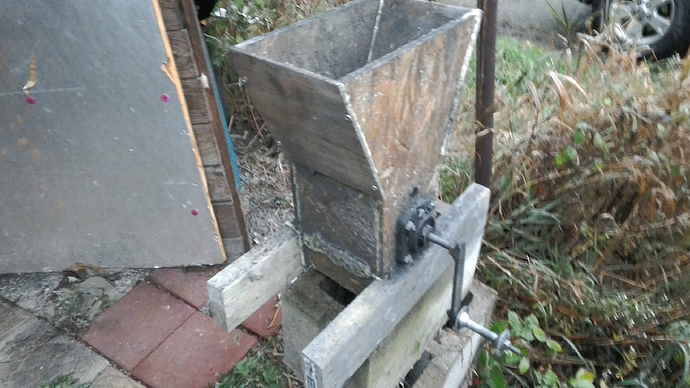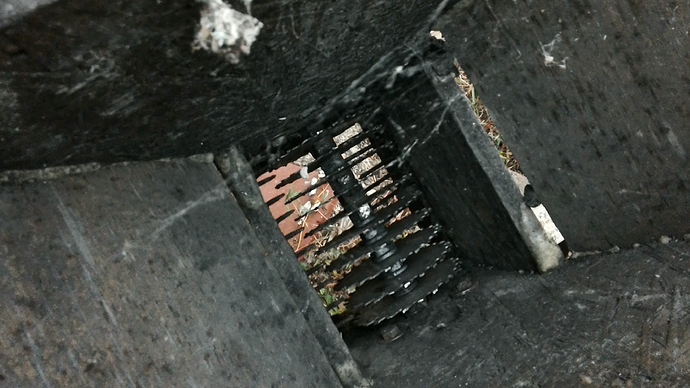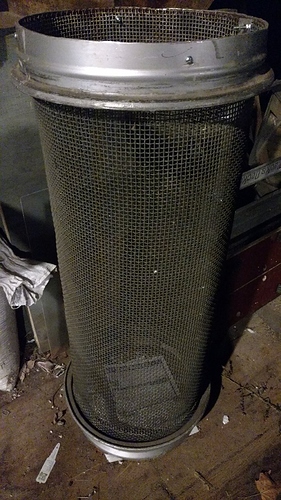Hi Wyatt, Just a suggestion, but what about using a rake that you adapt by adding a tooth every 3/4 inch or between the existing teeth. Use this to pull your charcoal to the front. From there, shovel it into a 55 gallon barrel that has a fairly tight fitting lid. If there is no oxygen, the charcoal will not continue to burn. When that drum is filled in a week or two, you can easily sift out the ash using an inclined screen or a rotating screen. The mesh should be about 1/4".
Gary in PA
I am leaning towards minimizing the ash in the harvest and then either presifting or allowing it to come out during the grind if it isn’t too thick. I like the rake idea, that combined with either a fine gapped fork or an adapted shovel might very well remove enough ash that it isn’t an issue anymore. I would like a rotary screen though so if I make one that would allow me to finish the ash removal as well as separate out metal from the raw charcoal before it gets to the grinder.
Oh, the dust is great. Makes for a good show. Just set a fan up out by the garden and don’t breath it… I love it.
I love it.
I have always got the bulk of my charcoal from my indoor wood burning stove , I can harvest around 25 litre tubs every few hours if I really want too , I burn hardwood pallet wood complete with nails and end plates ,so I empty ash , nails and charcoal out of the fire and into 2 saucepan’s at a time , I then carry them outside and dump into 25 litre tin and place lid on ready for the next refill .
The next day I take tin down to shredder and fill up a garden sieve and shake out dust and collect steel nails and end plates out of charcoal and dump the rest into the hopper and while grinding up I refill another sieve full and continue till 25 litre tins empty normally takes me about 8 mins from start to end and I refill the same tub with ground up clean charcoal and store ready to use .
Dave
Hello all, I did my first test run today with grinding up some charcoal, and I now understand a little better what I am up against. I sorted in 3 stages, first anything that stayed on a 1x2 weldwire screen got set aside for the BBQ, then I hammered the 1" pieces between 2 bricks untill it would fit through expanded mesh with a 3/8" narrow width. Lastly it went onto an 1/8" screen to remove the dust. Here is the result:

By the way, is this about the right size for a small engine?
It took probably about 2 hours to unload the retort, do the sorting, and make 5 gallons of graded charcoal. Clearly I need a better system. I also noticed that I was getting a fair amount of dust. To make 5 gallons of engine graded charcoal produced 2 gallons of fines. I know it has its place as a soil builder, but is that the sort of ratio you guys see with your methods?

Here is my feedstock, graded product, and fines.
I have been looking with interest at the different rotary grinders people have built, both hand operated and electric. How long is it taking people to process a 5 gallon (~20L) batch from coarse lumps to sifted engine size?
Looks about what I get, regarding the amount of fines. I actually screen twice. Once before the grinder, and once after the grinder. I have run my 55 gallon barrel system 275 times, according to my record book, and I have three 6 to 8 foot high compost piles I turn with a front end loader. (I’ll take all the fines I can get, and they get mixed into the compost piles!) My method takes lots of time, too, so I do it every day for a little while. My guess is that smashing the pieces between the bricks is creating more dust and fines. My sifting screen is set up near the path that leads from the house to my workshop, so I can walk past it, screen some, and then go on. I see a few pieces in your “engine ready” charcoal that I would grab and break them into two pieces. They should break easily. If not, then put them in the BBQ charcoal pail. My grinder is the hand operated one, so I save my sorted/screened charcoal for a windy day, put on a dust mask, some heavy gloves, and crank til my arm gives out. Then I screen it again, and go back to the grinder until the arm gets tired. I’ll get enough engine grade charcoal to fill a 55 gallon drum and then I attach the lid and seal it. Later, I open the lid to see if there is any moisture on the bottom of the lid. If so, I wait for a low humidity day, and open the barrel and let it dry out, then seal it back up. Eventually there is no more condensation, and I leave it sealed.
You could mix some of your “BBQ charcoal” in with fuel in a TLUD cooking stove, and now and then toss in a hunk while cooking. My stove makes very good small pieces of excellent charcoal. You might put on some gloves and just break it up with your hands, rather than smashing it with bricks.
After a charcoal grinding session, I notice the water I collect while showering is black!
Oh, I should mention that soft woods like cedar and pine make more dust and fines than hard wood like ironwood, mesquite, huisache or oak. I’m always on the lookout for dead limbs and downed trees for my charcoal making barrel, especially hardwoods.
Hi Carl , when i am making charcoal from my indoor wood fire i use saucepans to take the hot charcoal out of the house and onto the veranda to cool down by the time the fire needs more wood again the pans are cool enough to pour over a magnet and into a 25 litre drum once tipped into the drum i use a piece of 2x4 about 2 foot long and gently tap down on the charcoal and it nearly all breaks into nice smaller bits and allows me to get a lot more into the drum in fact i can get almost twice as much into the drum since doing it this way , i then leave it a day or two with lid on and wait till i have about 3 drums and grind up to a more uniform size with my garden shredder . since doing it this way the dust level has gone right down ,as the rotating hammers must have made the most dust i think .
Dave
I remember when I didn’t have a grinder! I made a hand grinder and that was like night and day. Have a modified Kemp hammer mill and that will grind almost as fast as I can lightly shovel it in. I think you make a bit more dust than I do but maybe the wind blows some of it away. Thinking about making a hand jaw crushed to save on using an electric motor but it really doesn’t take much juice to run the Kemp. I think my gasifier would run on the size charcoal that you have.
I use old saw blades that spin freely on a shaft with plywood spacers in between to cut/crush/snap charcoal. I started by making a multi-blade “ab roller” to run over charcoal on a flattened expanded metal screen. Then I suspended one of these multi-blade cutters in a box with a mating PVC drain pipe crankshaft with bolt head studs that pass in the space between the blades. The bolts are fastened to the PVC pipe in a spiral pattern so that only one bolt head at a time is passing between two of the free spinning blades. A hopper above allows chunks of charcoal to drop down to be grabbed by the bolt head studs and forced between the blades. Since the charcoal is basically snapping instead of being crushed or sawn, there is a lot less dust.
Hi Carl, Here is a video of how I process charcoal. I estimate it will take about five minutes to process a five gallon bucket of charcoal. The tilted screen really helps with sorting. I’d estimate about 15% of my charcoal yield turns into dust. The rest stays as engine char.
Gary in PA
Nice video Gary, looks like an efficient setup.
I also saw the one you use Bruce, and I really like the idea of doing something hand-cranked or maybe eventually pedal-powered. I could undoubtedly run a small grinder with my off-grid system, but the number of outlets/acre on our place is a very small decimal indeed, and its nice to be able to set up anywhere and crank away. Do you have a sense for how long it takes for you to run a 5 gallon batch, Bruce?
Bobmac - I like your setup a lot as well, and wanted to ask you about the trommel screen you built. Do you feel like it helps reduce the dust in the final product enough to justify the added complexity? In short, would you do it that way again if starting from scratch?
My brother recently dragged home an old schwinn, and I might think about pressing it into service as a grinder. I suspect it has steel rims, and I am thinking that I might be able to use that as my grinding wheel - maybe cut some notches into it to give it some teeth, and then make a stationary set of “anvils” like on Gary’s machine. I will keep you all posted!
Hi Carl, there is one thing about processing charcoal that I do not like, and it is all the black dust. As long as there is no breeze blowing my setup works great. You still have to load charcoal into the hopper and that means dust. Wear a dust mask.
The simplest is Gary’s with the shaker box.
If I was going to build it again it would be like his setup.
Bob
I like to follow the “charcoal Master’s” ideas so I built one like Gary’s and used collapsible saw horse legs so it stores easily and then I can also set up so prevailing winds take the dust away.
Here is my old hand grinder. I think the saws make more dust than my hammer mill.
wood bearing would work fine.
Hand rotary motion doesn’t seem natural to me so I want to try a back and fort motion next and that could be converted to rotary of a motor was needed.
My grinder is fast, but screening is still slow and dusty. I started a trommel project a while ago but don’t know when I will get back to it. I don’t have a good guess about how long it takes to process 5 gallons. I’ll try to remember to time things next time.
We made a sifter for clay/dirt. I bet the same method could be used for a charcoal sifter. W’ll try it and find out. I think there are some pics on Life goes on summer 2017
Hi Bruce, I went with the trommel design because it it is faster, but I can still grind faster than my trommel can pass and sort the charcoal. I have a hopper shoot below the grinder that will back up if I grind to fast, and over load the trommel. It just takes time to do it right and get rid of the charcoal dust fines. When feeding my grinder I am always looking for that one little brand piece of wood, that my grinder will not like, and might stop it from grinding.
Bob
I did some work on the new grinder today. I wanted to see if I could control the dust Passively before I incorporate a blower of some sort. Just a small tarp cut down the dust by about 60 percent. The quantity of dust was not that bad either. Not a fun experience but not the worst conditions I’ve been forced to work in. I like this path. Next time a larger tarp misting a whole garden bed…
Cheers, David
I just ran into this video. The guy is shelling corn with this, but I immediately thought of a charcoal grinder. I think it goes too fast, and I am not sure how it would handle brands, but it did a lot better on the corn, then I thought it would. It would still need to filter out the fines. I think the exit speed or lack thereof is what kind of impressed me.
Any thoughts?






